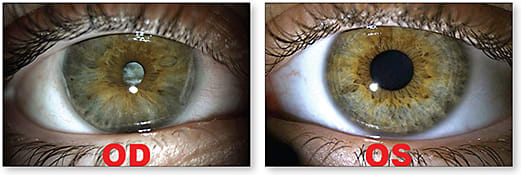From a cosmetic standpoint, tinted contact lenses can disguise existing undesirable ocular features (Figure 1). They can alter natural eye color, mask the sequelae of corneal and iris injuries, hide pupil abnormalities, and/or mimic ocular alignment. In some patients, tinted lenses serve a mainly prosthetic role to improve function and/or alleviate debilitating symptoms such as photophobia or double vision. As clinicians, what tools do we have today to assist us in choosing the right tint to suit the individual needs of our patients?

Diagnostic Fitting Sets
In-office diagnostic tinted soft lenses can provide you and your patients with an idea of custom color matching options. Some fitting sets come with various-sized opaque pupils, multiple iris tint patterns, limbal ring and starburst details, and different underprint shades for light occlusion. If you do not possess any diagnostic sets, a boxed dot-matrix tinted contact lens can be applied to the affected eye for approximate color matching and fit. This lens or a picture of it can be sent to your lab for custom tinted lens fabrication.
Alternatively, in-office tinting of a HEMA-based stock lens can allow a patient to trial various tints and tint intensities prior to ordering a final customized soft lens.
Color Swatches
Some labs provide reference cards that can aid in the color matching process. A high-quality photograph with the desired color swatch against the affected eye can be helpful. If using flash photography, ensure that there is no glare off the swatch, as this can limit the lab’s ability to correctly color match.
Digital Photography
Especially when ordering hand-painted lenses, always aim to get images with the best possible quality to send to your lab. For optimal photos, have the patient wear a white shirt and sit against a neutral, light-colored wall in a room with normal or natural illumination; take photos from one to two feet away at the most. Flash settings can improve lighting conditions if necessary.
Preferential Color Testing
Hand-held filters can be trialed in-office to decide what tint best alleviates debilitating symptoms of photophobia. Although rare, some offices may have access to a colorimeter, an instrument that independently adjusts hue, saturation, and brightness until a patient can comfortably read a selection of text. Visual stressors in patients, such as migraine sufferers and those who have dyslexia or who experience seizures, may be alleviated by a specific tint as determined by colorimetry, which can then be custom matched into a final lens.
Better First-Fit Success
For cosmetic and prosthetic lens fitting, a higher chance of first-fit success can come from employing one or more of these methods. Your lab can inform you of any additional measurements required to determine the optimal tint and fit to suit your patients’ needs. CLS





